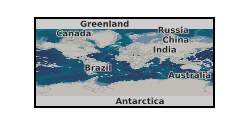Pliocene
Type of resources
Topics
Keywords
Contact for the resource
Provided by
Years
Formats
Update frequencies
-

Benthic stable isotope (carbon and oxygen) data from IODP Site U1445. Generated by Yasmin Bokhari-Friberg, supervisied by Kate Littler and Pallavi Anand.
-

We report sedimentary coatings and fish teeth neodymium isotope values – tracers for water-mass mixing – from deep-water International Ocean Discovery Program (IODP) Site U1438 (4.7 km water depth) in the Philippine Sea, northwest Pacific Ocean. The time period encompasses the last 20 million years.
-

Temperature reconstructions indicate that the Pliocene was ~3 degrees C warmer globally than today, and several recent reconstructions of Pliocene atmospheric CO2 indicate that it was above pre-industrial levels and similar to those likely to be seen this century. However, many of these reconstructions have been of relatively low temporal resolution, meaning that these records may have failed to capture variations associated with the 41 Kyr glacial-interglacial cycles thought to operate in the Pliocene. These data represent new, high temporal resolution alkenone carbon isotope based record of pCO2 spanning 0 to 0.2 and 2.6 to 3.3 million years ago from ODP Site 999 (supplementing our other data repository focused on 2.8 to 3.3 million years ago). Our record allows a) direct comparison of alkenone-derived pCO2 from the Pleistocene to that of the Pliocene and b) comparison of the former to the ice core record. The raw data are sea surface temperature estimates from the Uk'37 proxy, foraminiferal and alkenone d13C values, from which carbon isotope fractionation during photosynthesis (ep) can be calculated. Using nutrient concentrations (growth rate correction) and SSTs, these ep values can be converted into [CO2(aq)] which in turn can be used to calculate pCO2.
-

Photographs, 18O/16O isotopic ratios, XRF-derived elemental and N, C concentration data are provided for sediment cores from Deep Sea Drilling Project Site 225, central Red Sea. This site was originally drilled in April 1972 by rotatary drilling to recover cores through parts of the Plio-Pleistocene sediments for studies of past Red Sea water properties and regional climate. The rotary drilling disturbed the sediments by varied amounts, though left some 1.5-m sections of core almost intact. The X-ray fluorescence (XRF) data comprise elemental proportions for the core archive sections selected where they showed the least drilling disturbance. These and the core photographs were obtained at Kochi University, Japan, using an ITRAX core scanner during 2023 and 2024. Given the age of the cores, the archive sections are not perfectly flat, hence the ITRAX-derived elemental data may be distorted by varied distance between the sensor and the core, as well as by cracks within the core. The user needs to judge these data against the core photographs. As the lighter 16O isotope is evaporated preferentially over 18O and tends to get locked up in ice sheets during glacial periods, measurements of the ratio 18O/16O in carbonate sediments are often useful for recording evidence of global climatic cycles. In the Red Sea, the ratio is further affected by local evaporation, as the basin has been variably isolated from the Indian Ocean, partly as a result of sea-level variations affecting the exchange of water between the basins. Samples of ~20 cm3 were selected with two sets of intervals. Coarse-interval sampling was chosen spanning the Plio-Pleistocene for reconnaissance, while denser sampling was carried out across particular intervals of scientific interest. Within these intervals, the shells of foraminifera were separated into different species. Shells of Cibicidoides mundulus were primarily selected for measurements of 18O/16O. Analyses were carried out in 2024 at the University of Southampton (UK) using a Kiel carbonate device coupled to a Mat253 IRMS. XRF core scanning and sampling were carried out by technical staff of the Marine Core Research Institute, Kochi University under supervision of the IODP Core Curator Yusuke Kubo. Diederik Liebrand disaggregated the samples, separated the foraminifera shells and carried out the oxygen isotopic measurements. Selected samples were also analysed for nitrogen and carbon contents (weight percent of bulk sample in columns B and C) at the University of Liverpool by Steve Crowley.
-

The data comprises a multi-proxy dataset of 49 samples spanning approximately the time interval from 1.8-3.9 Ma according to the currently available shipboard age model from offshore the Limpopo River, southwest Indian Ocean. Data includes major and trace element chemistry and K-Ar ages from the clay fraction (<2um), radiogenic isotope geochemistry, stable isotopes of planktonic foraminifera Globigerinoides ruber. The data set is now online with a citable DOI, although with an embargo till September 2019, http://dx.doi.org/10.1594/IEDA/100719
-
The datasets provide neodymium and strontium isotope composition of Pliocene detrital sediments and additional regional core top samples, diatom species counts and biogenic opal content. These data related to Pliocene marine sediments recovered offshore of Adelie Land, East Antarctica from IODP (International Ocean Discovery Program) Site 318-U1361. The data reveal dynamic behaviour of the East Antarctic ice sheet in the vicinity of the low-lying Wilkes Subglacial Basin during times of past climatic warmth. Sedimentary sequences deposited between 5.3 and 3.3 million years ago indicate increases in Southern Ocean surface water productivity, associated with elevated circum Antarctic temperatures. The geochemical provenance of detrital material deposited during these warm intervals suggests active erosion of continental bedrock from within the Wilkes Subglacial Basin, an area today buried beneath the East Antarctic ice sheet. This erosion is interpreted to be associated with retreat of the ice sheet margin several hundreds of kilometres inland and concludes that the East Antarctic ice sheet was sensitive to climatic warmth during the Pliocene.
 NERC Data Catalogue Service
NERC Data Catalogue Service